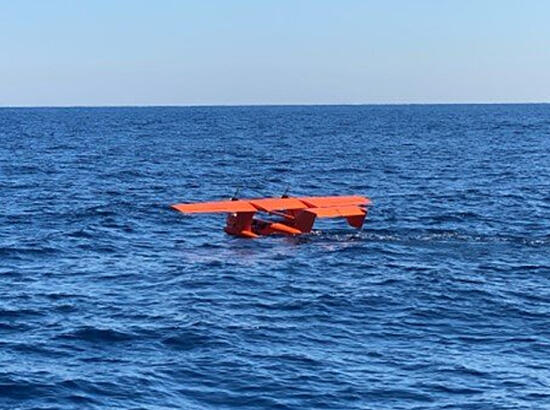Observation equipment attached to ships and buoys is used for deep seafloor observations in surveys and research. However, these vessels have issues, including high costs and a limited ability to remain at fixed locations on the sea surface, limiting the frequency of observations. A research group consisting of Associate Professor Yusuke Yokota from the Institute of Industrial Science, the University of Tokyo, Associate Professor Yoshiaki Hirakawa from Yokohama National University, and the Space Entertainment Laboratory, has developed a sea-surface landing unmanned aerial vehicle (UAV) with an attached undersea communication device, enabling acoustic communication and ranging between the UAV on the surface of the sea and the seafloor at depths of 1,000 meters or deeper for the first time

Provided by the University of Tokyo
The research group has made this possible by reducing the size and weight of the underwater communications equipment installed on UAVs. The group then upgraded a UAV capable of taking off and landing on the ocean under autonomous control with advanced functionality to provide control on the sea surface for seafloor observations. These improvements enabled communication and ranging with a submarine acoustic reference station located on the seafloor at a depth of approximately 1,300 meters in Sagami Bay.
The UAV used in the experiment was the UAV HAMADORI6000 prototype, a newly developed amphibian model by Space Entertainment Laboratory with a wingspan of six meters and a cruising speed of 110 kilometers per hour. It has a take-off distance of about 30 meters, so it can take off and land freely over the open sea in many situations. This model is being developed to eventually enable a flight time of up to eight hours and 400 nautical miles. The total weight of the observation equipment (payload) carried in this experiment was six kilograms, significantly lighter than that of a typical seafloor observation device.
Communicating over long distances with the deep seafloor using sound requires that acoustic signals be transmitted in a stable environment. During the experiment period, Sagami Bay had a maximum wind speed of approximately eight meters and a maximum wave height of approximately 1.5 meters but controlling the speed and attitude of the aircraft enabled it to travel smoothly on the surface, providing stable acoustic communications. The UAV is expected to enable communication and observation of deep seafloors down to a depth of about 5,000 meters, enabling observations of a wide area of the ocean floor around Japan.
Yokota said, "Most marine equipment to date has been constructed to be heavy enough to sink. Unlike these conventional observation methods, we needed to reduce the weight of the equipment in the development process. With its high mobility, the amphibian-type UAV we produced for seafloor observation enables high-speed, high-efficiency, and real-time acquisition of information about the seafloor. In the future, we aim to improve the speed of acquiring information from this environment."
This article has been translated by JST with permission from The Science News Ltd. (https://sci-news.co.jp/). Unauthorized reproduction of the article and photographs is prohibited.




